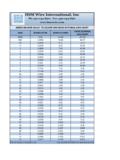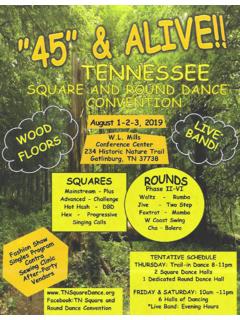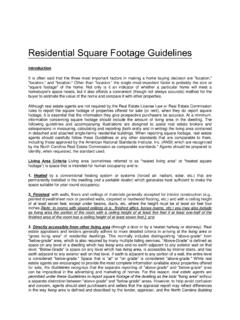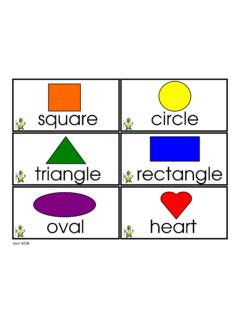Transcription of Building Your Own T-Square Style Table-Saw Fence
1 Building your Own T-Square Style Table-Saw Fence By Joe Emenaker 2 Contents Building your Own T-Square Style Table-Saw 1 Contents .. 2 Before We Begin .. 3 Introduction .. 3 Contact Info .. 3 Credits .. 4 Errata .. 4 Copyright .. 4 Disclaimer .. 4 On a More Serious 4 Construction ..6 Anatomy of a T-Square Fence .. 6 Construction .. 9 Finishing .. 15 Victory Lap (the finished photos) .. 16 CAD 17 Clamp Mount .. 17 Clamp Cam .. 18 Tortion Plate .. 19 3-D View of the Assembly .. 20 3 Before We Begin Introduction The two grim realities most Table-Saw owners are faced with are: 1. Unless you spent a lot of money on your Table-Saw , the Fence that came with it isn t very good. 2. At around $300, the after-market fences are way more than most of us can bear to part with. Although some of the after-market fences can be quite complicated, with pulleys and whatnot to keep them parallel, some others are quite simple in design. In fact, the simplest of them all is the T-Square Style and, astoundingly enough, they are regarded by everyone I ve asked as the best you can get.
2 The T-Square Style is so simple, in fact, that it requires no specially-cast parts and only about 2 moving parts. Just about everything you need to make one can be bought either from your local hardware store or from your local steel supplier. They can be built fairly quickly, too. I built mine in about 20-30 hours of shop time, but that s because I was tinkering with the design and spent a lot of time cutting pieces to length. If you knew the lengths of all of the pieces you needed (and I ll tell you what those lengths are), then you could probably throw one of these together in about 10 hours or so. Now, although the design of the T-Square Fence is simple, keep in mind that it is very specific. Although you can buy all of the parts from a steel supplier, they have to be joined together such that everything lines up correctly. That s the purpose of this document. Although you can find web pages of people showing off their home-made T-Square fences, they always show you the finished product and they talk about how fun it was to build, but they never tell you the dimensions of all of the and the dimensions but now you ll have some that will work.
3 Note that these aren t the only dimensions that will work. You can use smaller or bigger pieces as you care to, and I ll try to point out what other adjustments you need to make if you substitute thicker or thinner pieces somewhere. All of the drafting drawings were done using AutoDesk Inventor. It s an incredible piece of software. I m sure I m not using 10% of its capability, but it has saved me tons of time and frustration by letting me see how the pieces all fit together (or don t fit together) without actually having to build a prototype. As far as machinery goes, I used a drill-press and a belt-sander most of all. I used my radial-arm saw (fitted with a metal cutting blade) to cut many pieces to the proper length. If you have access to an equivalent metal-cutting capability (metal-cutting band saw, having it cut at your steel supplier, etc), that will do just as well. Also keep in mind that this design is for a cabinet - Style of those big, enclosed 400-500 pound jobbies.
4 I would hesitate to make this exact design for a contractor- Style or bench-top saw for fear that this thing would tip it over or, at the least, be overkill. All in all, I think this Fence weighs over 80 pounds or so. If you re making one for a smaller saw, then you can shrink some of the pieces as you see fit to make it a little more reasonable. Contact Info If you need to get in touch with me to discuss an error in the document, make a suggestion, or just say thanks , you can reach me at: If you need the latest copy of this document, you should be able to get it from: 4 Credits Credit should be given to John A. Swensen for making the first webpage I ever saw describing how to make a T-Square Fence ( ~swensen/machines/ ). Special thanks to Keith Kidder for Building one: ( ) and sending me lots of pictures of it. Errata The Fence you see pictured in the photos does not match the one shown in the drafting drawings or the 3D renderings.
5 The photos are of my first attempt at making the Fence . It had a few glitches that, if I did it all over again, I d want to fix. So, I fixed them in the drawings so that you ll have a better Fence than I do. If you find any other errors in this document (ie, wrong dimensions, something doesn t fit right) or if you have any clever suggestions on how to make the Fence even better, please let me know. Also, keep in mind that the colors used in the CAD drawings are for contrast purposes. The Fence tube isn t really orange and the clamp mounts aren t really teal. Copyright You can pretty much do anything you want with this document except charge money for it or claim that you wrote it. You can print it, send copies off to everyone you know, share it via P2P file-sharing networks, post it on newsgroups, or even put it on your web site. In fact, please put it on your web site, just in case I ever move my website or take it down, people can still get to this document.
6 Disclaimer For fear that someone is going to hurt themselves while Building this or while using the finished product and then sue me, I feel compelled to issue the following warning. Don t build this. You ll probably lose an eye. In fact, you ll be lucky if you lose just one. Furthermore, if you don t end up killing your spouse and children in the process of Building /using it, then they ll certainly leave you because you build it. You will die alone and penniless in a dark foul-smelling alleyway. So, if any of these things actually happen to you, you were warned. On a More Serious Note While I was in the home stretch of Building this thing, I got pretty absorbed in getting it completed and I cut a few corners in the better judgment department. Specifically, I didn t bother with opening my garage door while brazing the pieces together, and I ended up doing a bit more brazing than I was planning and I did all of it in one session. So, I didn t really realize that the garage was filling up with all kinds of fumes from the melting brass and the flux and whatever funny chemicals were being formed when the flux de-oxidized the metal parts.
7 5 Later that evening, I felt like I had been in a smog alert in , where it hurts to take a deep breath. I also had body aches and, overall, felt pretty lethargic. When my girlfriend heard what I had done (and how I was feeling) she jumped on the net to see if there was a name for what I had done to myself. According to her, the common name for it is Metal Fume Fever . The milder symptoms are the ones I ve described but, in more extreme cases and over prolonged exposure, it can cause renal distress, there s supposedly been some correlation of it to Parkinson s disease, and I guess there have been fatalities reported from it as well. Now, I didn t get a very heavy dose of it, and I was feeling myself again within about 12-18 hours. But it s much better to be safe than lucky, and I m planning on doing all of my future welding outdoors from now on. Please, folks, read and follow the safety precautions on all of the welding/painting/stripping/etching materials you plan to use.
8 Now, on with the 6 Construction Anatomy of a T-Square Fence Although these parts probably have different names in the mechanical engineering world, I m going to tell you what I call these parts, so that you ll know what I m talking about throughout the rest of the document. F B C D E A I J K L H G The entire project, attached to a Table-Saw table 7 The pieces are called as follows: A. Front Guide Rail or Front Rail . Together with part B, the Guide Tube , they form the Front Guide Assembly . B. Guide Tube . Together with part A, the Front Guide Rail , they form the Front Guide Assembly . C. Clamping Bracket (Qty. 2). These attach to the back of the Fence Tube (F) and hold the Clamping Cam (D) and the Pressure Plate (E) D. Clamping Cam . This is a cylinder with an off-center hole drilled through it to make it into a cam. When turned, it forces the Pressure Plate (E) to press against the Guide Tube (B) E. Pressure Plate.
9 This is a bent piece of sheet-metal used to prevent the Clamping Cam (D) from wearing directly against the Guide Tube (B) F. Fence Tube . This is the Fence itself. Aside from the Sacrificial Fences (G), it s the only thing that rests on the table (I). G. Sacrificial Fences . These bolt onto the Fence Tube (F) and form expendable, replaceable surfaces for the Fence . H. Rear Rail . This provides support for the far end of the Fence Tube (F). Partly so that it can ride just off of the surface of the table (I) and partly so that it doesn t fall when you move your Fence way off to the right. I. table . We won t be Building this. J. Squaring Angle . This is a piece of angle-iron welded to the Fence Tube (F) which keeps it square to the Guide Tube (B). The squareness is adjusted with the Horizontal Adjustment Plate (M) K. Tortion Plate . This provides some separation between the Fence Tube (F) and the Guide Tube (B) and it also adds some strength against twisting at the interface between these two pieces.
10 L. Spacer Plate . This provides some separation as well. If this weren t here, the top of the Tortion Plate (K) would be flush with the bottom of the Fence Tube (F), which is going to ride just above the surface of the which would mean that the top of the Tortion Plate will be just above M N L E Underside of the Fence assembly 8the which means that it would be in the way when you tried to rip something. So, to keep the Tortion Plate below the surface of the table , we add this spacer. (NOTE: The one that I built that is in the picture does NOT have a spacer plate in it! So, if you have trouble seeing it in the pictures, it s because it s not there). M. Horizontal Adjustment Bar . This is a piece of thick sheet metal with some UHMW slider feet on it. The feet slide against the Guide Tube (B). There is an adjustment screw in the Squaring Angle (J) behind each of the feet to adjust for squareness. N. Vertical Adjustment Bar . This is just like the horizontal one, except that this is to lift the Fence just off of the surface of the table and also to make sure that the sides of the Fence Tube (F) are perpendicular to the surface of the table (I).







